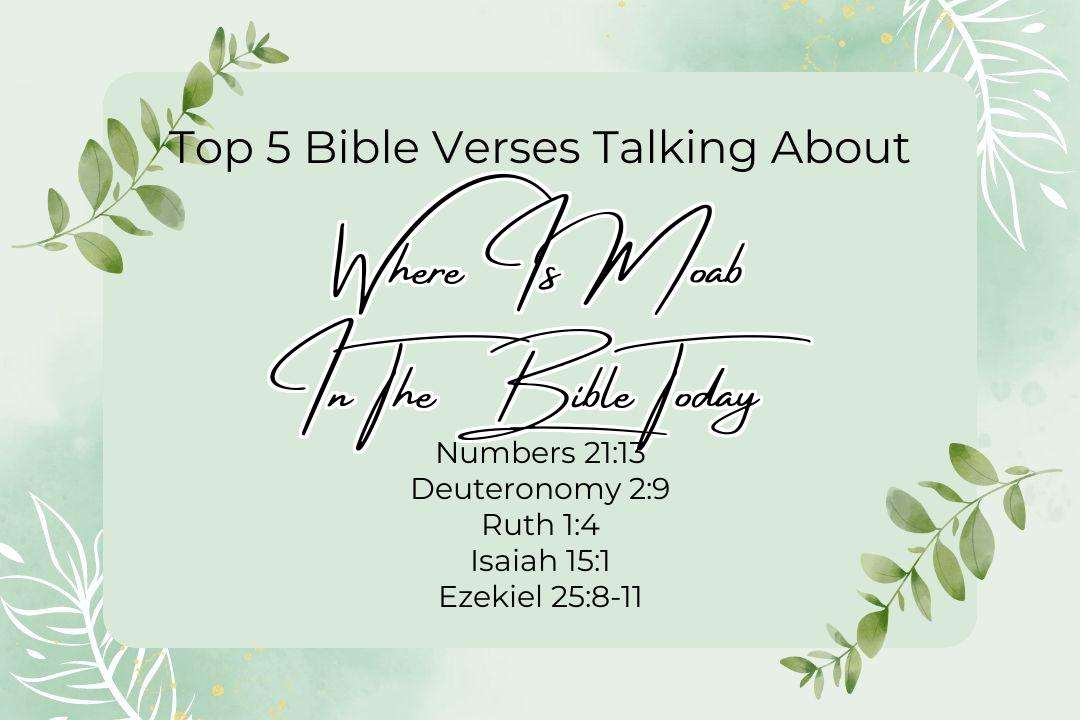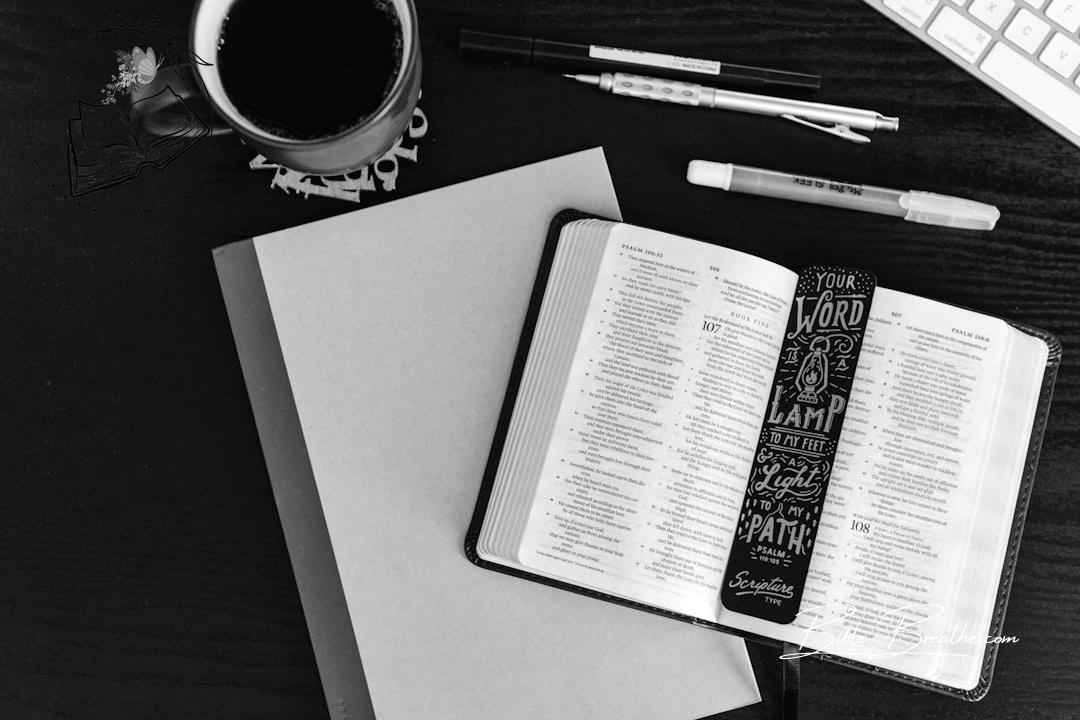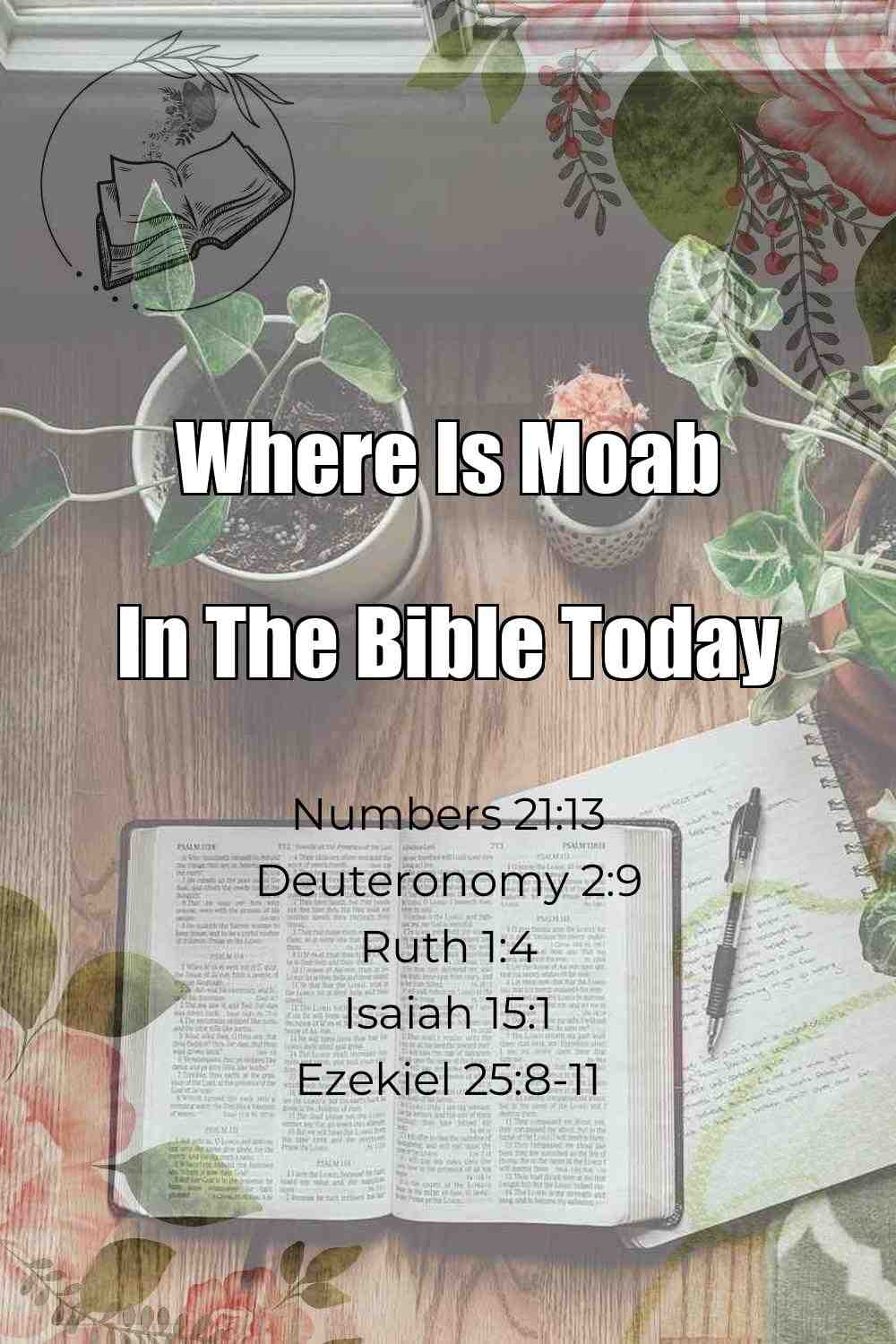As I picture myself trekking where the likes of Moses and Abraham once walked, a shiver runs down my spine – what exactly did those long-since-gone ancient kingdoms look like? I recall learning about this mystifying land east of the salty Dead Sea – Moab, was it? It’s a wonder how a place full with secrets from eons ago and tales of devout faith sort of just blipped off the radar… nowadays I found myself scanning through pages of Bible going – so where is Moab hiding? I’m setting out on a journey to dust the cobwebs and expose this spellbinding place for what it’s worth – think you’ll join me?
Top 5 Bible Verses About Where Is Moab In The Bible Today
I came across these verses while digging deeper into the topic, and honestly, they’ve been a huge help in wrapping my head around the whole thing. The bits of scripture I’m about to share offer some pretty interesting insights that, in my opinion, totally enhance our understanding of where Moab fits in.

Picture by BibleBreathe.com about Where Is Moab In The Bible Today
Geographical Location of Moab in the Bible
As I dig deeper into the stories of old about Moab, the Bible starts to feel like this whole other world that somehow touches my own life now. The more I read, the more alive ancient history starts feeling.
Moab’s Location East of the Dead Sea
It’s wild to think that I could stand right there on the eastern edge of the Dead Sea, baking under that desert sun. You basically got the land of Moab, right where modern-day Jordan sits, I guess. According to the Bible,
“The Horims also dwelt in Seir beforetime; but the children of Esau succeeded them, when they had destroyed them from before them, and dwelt in their stead; as Israel did unto the land of his possession, which the Lord gave unto them. And these are the kings that reigned in Edom, which country he also ruled over: first Balak, the son of Beor, and the name of his city was Dinhabah. And when Balak was dead, Jobab the son of Zerah of Bozrah reigned in his stead. And these are the kings that reigned in the land of Edom.” (1 Chronicles 1:39-43, 50, KJV, vs rearranged for quote).
What gets me about Moab’s location is how big a part it played in all these back-and-forth situations they had with Israel next door.
Moab’s Borders with Ancient Israel
Moab and Israel essentially were neighbors, separated by a thin river called the Arnon. You find stuff about this in the Bible too –
“And this land, which we possessed at that time, from Aroer, which is by the river Arnon, and half mount Gilead, and the cities thereof, gave I unto the Reubenites and to the Gadites.” (Deuteronomy 3:12, KJV).
Having Moab and Israel right up against each other turned into this whirlpool of sharing ideas, straight up clashes, and unintentionally forming the histories of these two nations.
Notable Cities in Moab, Including Dibon and Kir-hareseth
Some pretty notable cities show up in Moab too. Dibon’s famous for the discovery of the Mesha Stele – that historical thing – while Kir-hareseth pops up as Moab’s capital in texts from back then. Somewhere, there’s something about this all going down in that mix of friction that happened between Israel and Moab.
Its talked about in 2 Kings 3:27, too,
“Then he took his eldest son that should have reigned in his stead, and offered him for a burnt offering upon the wall. And there was great indignation against Israel: and they departed from him, and returned to their own land.” (2 Kings 3:27, KJV).
Moab in Modern Times
The Location of Moab in Modern-Day Jordan
When I was younger, reading about Moab in the Bible always caught my imagination. Those ancient stories about its people have stuck with me ever since. Got me thinking the other day though – where does Moab come up in the Bible nowadays? Has this place transformed, or is it pretty much still baron?
Digging into this deeper… it seems it’s actually part of Jordan. Yep – that’s the country we’re talking about. Landscapes that seriously take your breath away. A history which seriously is like few others. Plus culture all over the shop. Specifically though, Moab’s in southern Jordan – pretty close to the Dead Sea.
“And the children of Israel set forward, and pitched in the plains of Moab on this side Jordan by Jericho.” (Numbers 22:1, KJV).
That particular verse still gets me thinking about how significant Moab was back then, when it comes to biblical narratives, you know, the place where the Israelites camped – waiting for their cue to go into the Promised Land.
Archaeological Sites in Moab, Including Dhiban and Umm ar-Rasas
Moab’s really not that empty these days. Archaeologists have kind of set themselves up here as there’s tons of historic stuff to look over. You’ve got two of these places – Dhiban and Umm ar-Rasas – I’m still learning about. Dhiban was essentially the main Moab city in the Iron Age – known to others as Dibon. And archaeologists keep finding stuff – they’ve gotten hold of a pretty sweet haul of ceramics, loads of money, and writings.
However you pronounce it – Umm ar-Rasas… yeah it’s on UNESCO’s World Heritage list now. What they have on show in terms of mosaic art there, next to a hunk of historical backdrop, is more-than-a-reason for many a visit. Umm ar-Rasas in past years might have centered on commerce etc.
The Impact of Modernization on the Region of Moab
Not long ago, looking back at this place’s background did put into my forefront just how much society marching ahead with it’s times changes environments. I would’ve imagined Moab looking straight fallow still but – it has instead morphed into somewhere the tourist hordes visit these days – they come all yearlong! Government initiatives like highway paving coupled with sprouts of establishments of all kind in short succession have paved opportunity – helping bring around enough to help workers in nearby whereabouts afford more readily.
Tourism does put bad strains out too while marching ‘for progress.’ The more visitors you get going to a little single destination just, at those rates – not ideal management planning in sync.
We see or look or listen – or stay wherever we view ourselves standing out… standing on and viewing or walking etc on this soil now but… well history indeed is more valuable – you think learning things doesn’t shift something? Helps us so we end up so grateful still.
My Journey through the Biblical History of Moab

Photo modified by BibleBreathe.com. Original photo by Kelly Sikkema on Unsplash
I’ve always been fascinated by the intricate web of relationships between ancient nations, and my exploration of Moab’s biblical history has left me with more questions than answers. Take for instance, where does Moab feature in the Bible today? Its definitely worth a closer look at how this nation came to be, and what it means.
How Moab Emerged as a Nation in the Bible
To get to the roots of Moab’s story, I began by reading up on its founder. Now Moab was the firstborn of Lot’s kids with his daughters, the story goes (Genesis 19:30-38, KJV). After Sodom and Gomorrah got destroyed, Lot’s daughters got a bit desperate, thinking they were the only ones left. So, they got him drunk, did their thing, and had kids with him – not exactly your average family affair. Anyway, Moab is the guy this whole nation is named after.
“Thus were both the daughters of Lot with child by their father.” (Genesis 19:36, KJV).
This whole thing sets the stage for some pretty complicated dynamics between Moab and ancient Israel.
The Ups and Downs of the Moab-Israel Relationship
In the Old Testament, the vibe between Moab and Israel is kinda all over the place – part conflict, part cooperation, you know? They had their fair share of squabbles over land and foreign influence, but then there’s times they seemed to be on the same page, intermarrying and all that jazz, like with Ruth’s story.
My Favorite Bit: Biblical Highlights Featuring Moab
Now, one story that really sticks out is Ruth, the Moabite lady who somehow ended up part of King David’s ancestry (Ruth 1-4, KJV). What really gets me is how loyal and faithful she was to Naomi, her Israelite mother-in-law – goes to show that even when our cultural backgrounds clash, we can find love and understanding.
“And Ruth said, Intreat me not to leave thee, or to return from following after thee: for whither thou goest, I will go; and where thou lodgest, I will lodge: thy people shall be my people, and thy God my God:” (Ruth 1:16, KJV).
Ruth’s story resonates pretty strongly in our world today – it’s all about forging connections across cultural divides and letting faith bring us closer together. Reflecting on the biblical significance of Moab, it seems pretty evident that these ancient stories still carry a ton of weight.
Places I Visited in Moab
Thinkin back on all I’ve read about Moab in the Bible, it still holds a sense of wonder. If you’re as curious as me, you’re probaby wonderin where exactly it is today, what’s there to see… stuff like that.
Walkin through the Ancient City of Petra
Petra, an ancient city near Moab, has had me fascinated since forever. Those Nabateans – genius architects & craftsmen – literally cut their temples & monuments into sandstone cliffs 2000 years ago! Walking the narrow canyon – the Siq – it was like steppin into Bible land; Treasury building loomin before me, shinin like a mirage.
The Bible says,
“The mountains shall bring peace to the people, and the little hills, by righteousness.” (Psalm 72:3, KJV).
It was like the mountains themselves bore witness to all the history & stories in Petra; a real sense of peace, connection with the world.
Dead Sea & Beyond, My Adventure Continues
You can’t possibly visit Moab & miss out on the breathtaking Dead Sea (along its western border); like nothin I’ve ever seen! Effortlessly floatin on them salty waters – burdens of everyday life just vanished, felt like I was weightless.
But there’s way more to Moab than just the Dead Sea & Petra; there’s more awesome sights. I checked out Wadi Rum too – them insane sandstone mountains, valleys. Then there’s Aqaba – coastal town with a proper rich history datin way back. Whoever you are – adventurer, history buff or just some one needin a little R&R – Moab is definitely the place.
If, like me, you too are wonderin where the Moab from the Bible is nowadays… trust me, I recommend you visit; read a bit more of its story y’know? Saint Augustine did say “The world is a book, and those who do not travel read only one page.” You’d regret missin the next chapter in Moab’s tale.
Historical and Cultural Heritage of Moab
The Moabite Stone: it’s pretty cool, I guess
Standing out there in the scrubby landscape, wind in my hair, I’m thinking about all this history hidden just out of sight. So, like, I found out about the Moabite Stone – some old inscription they unearthed in Dhiban, Jordan – it’s pretty fascinatin’…gives you a glimpse into what life was like way back then.
Etched onto this stone slab’s the story of the Moabite’s king, Mesha – all his conquests, and the fact that his people lived like, over 2800 years ago. Now this stone is super valuable ’cause it dates back to like 840 BC or whatever and you can really learn alot about those Moabites and their ways.
Delving into Ancient Moab’s Practices
In the Bible, it says,
“And the children of Israel did evil in the sight of the Lord, and served Baalim” (Judges 2:11, KJV).
Those words got me thinkin’, what was goin’ on back then? Apparently them Moabites were pretty skilled at gettin’ the Israelites to worship false idols… I guess they was bad influencers or somethin’. Readin’ deeper, you start seein’ that those old practices – all the sacrifices, rites, and rituals – defined Moabite culture. Their lives weren’t divided, ya’ know, between church and state; and it shows us humans don’t change that much…still findin’ our way to those shiny new idols.
Tracing the Moabite Legacy
Just walkin’ through Jordan’s towns and villages nowadays, you can see some of those old Moabite vibes still present…clothing, beautiful crafted textiles…it’s all got a history behind it.
Stuff we do, things we decide – even our way of life, it’s all got echoes…down the line… What’s our own story gonna look like after we’re gone? We gonna leave behind proof we stood for somethin’ good? It’s up to us and not like, you can turn back the clock…so we should prolly consider our ways…
Archaeological Excavations in Moab
Excavations at Dhiban and other Moabite sites
Reflectin on my journey, Moab keeps comin to mind – how archaeology brings Bible stories to life, y’know? Moab, that ancient kingdom in the Near East, has been gone over with a fine-tooth comb, what with all the digs and research bein done at Dhiban, the capital.
Located in modern-day Jordan, the site of Dhiban is a goldmine of archaeological riches that’s shed light onto Moab’s history and the daily lives of its people. From huge palace buildings to temples – these have given archaeologists a glimpse into what Moabite architecture must of looked like.
Discoveries shedding light on Moab’s history and culture
It’s mind boggling the amount of stuff found at Dhiban. Broken pottery, coins that have been buried for centuries, and writings that are still bein deciphered – this is the stuff history is made of. One such findin is the stele of Mesha, a royal slab from way back, give or take a couple of thousand years. The writing on it basically spills the beans about Moab, their king, and them goin head to head with the Israelites.
We’s really lucked out with the Mesha Stele. Not only does it prove Moab was a thing but you can tell there was all this drama and fightin amongst these kingdoms way back. No surprise, we all knew humans been squabblin for eons; a shame we don’t learn more from the ancient folk, instead stuck to makin the same blunders over n’ over.
“For the wrath of God is revealed from heaven against all ungodliness and unrighteousness of men, who hold the truth in unrighteousness” (Romans 1:18, KJV).
That passage hits home for me. Reminds me that us lookin to find out the whys and wherefores of all this history, we gotta dig deep, stay honest, be prepared to have some uncomfortable truths outed.
Ongoing archaeological research in the region of Moab
Its a big ol’site but we ain’t done learnin yet, no sirree. Our knowledge of Moab today could use some beefin up, we need to know our limitations and Moab just doesn’t quit givein us answers like some ol wise giant in the desert…and yeah it keeps tellin on us – human nature (of course I have a lot of respect for whomever chose this road of research).
What Do You Think?
What did you find most compelling about this verse? Share your thoughts or questions in the comments.
Think others would find this helpful? Share it and explore more at BibleBreathe.com!

Photo modified by BibleBreathe.com. Original photo on Unsplash.
Frequently Asked Questions About Where Is Moab In The Bible Today
Where is Moab located in the modern world?
Honestly, I was curious about this too – turns out Moab’s in Jordan nowadays, just east of the Dead Sea; pretty cool how much history’s packed into that one spot.
What is the significance of Moab in the Bible?
To me, Moab’s like this huge paradox – it’s where Israel’s faith got tested, but also where Ruth, a Moabite lady, shows up and becomes part of Jesus’ family, kinda proving God loves everyone, no matter what.
Is Moab mentioned in the New Testament?
Moab does get a mention in the New Testament, in Romans 11:25-32, and there’s this one part in Revelation 18:2-3, it’s all about God judging and saving, makes me think about how He’s all merciful and stuff.
Matt Turner
I’m Matt, and I love breaking down Bible verses in a way that’s easy to understand and apply to everyday life. My goal is to help you connect with God’s Word and find practical ways to live it out. Whether you’re new to the Bible or just looking for some fresh insights, I’m here to walk with you and share what I’ve learned along the way.

